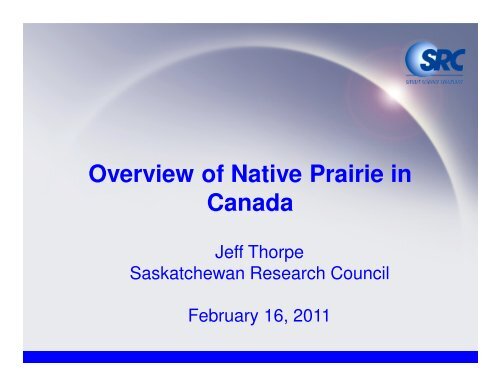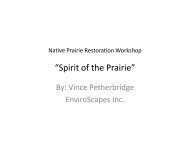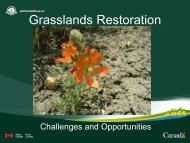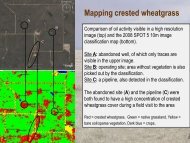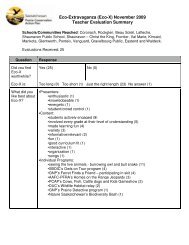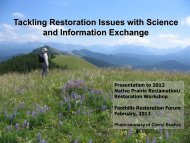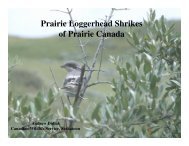Overview of Native Prairie in Canada - Jeff Thorpe - Saskatchewan
Overview of Native Prairie in Canada - Jeff Thorpe - Saskatchewan
Overview of Native Prairie in Canada - Jeff Thorpe - Saskatchewan
You also want an ePaper? Increase the reach of your titles
YUMPU automatically turns print PDFs into web optimized ePapers that Google loves.
<strong>Overview</strong> <strong>of</strong> <strong>Native</strong> <strong>Prairie</strong> <strong>in</strong><br />
<strong>Canada</strong><br />
<strong>Jeff</strong> <strong>Thorpe</strong><br />
<strong>Saskatchewan</strong> Research Council<br />
February 16, 2011<br />
smart science solutions
Ecosystem classification<br />
• We have a wide variety <strong>of</strong> different<br />
grassland types.<br />
• Ecosystem classification provides a<br />
consistent basis for describ<strong>in</strong>g types and<br />
mak<strong>in</strong>g management recommendations.<br />
• Hierarchical system:<br />
– ecozones and ecoregions represent broad<br />
climatic trends.<br />
– ecosites represent variation with<strong>in</strong> ecoregions<br />
(topography, soils, moisture, sal<strong>in</strong>ity).
Ecoregions and CMI<br />
ECOREGION<br />
Forested ecoregions<br />
Aspen Parkland Ecoregion<br />
Moist Mixed Grassland Ecoregion<br />
Mixed Grassland Ecoregion<br />
(Dry Mixed Grassland)<br />
CLIMATIC MOISTURE INDEX<br />
Above 0 mm<br />
0 to -175 mm<br />
-175 to -250 mm<br />
Below -250 mm<br />
Below -325 mm
Ecosites used <strong>in</strong> <strong>Saskatchewan</strong><br />
Badlands<br />
Overflow<br />
Th<strong>in</strong><br />
Dry Meadow<br />
DRY<br />
Gravelly<br />
MOIST<br />
Wet Meadow<br />
Dunes<br />
Shallow Marsh<br />
Solonetzic<br />
Deep Marsh<br />
Sand<br />
Sal<strong>in</strong>e Upland<br />
ZONAL<br />
Sandy Loam<br />
Loam<br />
SALINE<br />
Sal<strong>in</strong>e Dry Meadow<br />
Sal<strong>in</strong>e Wet Meadow<br />
Clay<br />
Sal<strong>in</strong>e Shallow Marsh<br />
Sal<strong>in</strong>e Deep Marsh
Loam Ecosite <strong>in</strong> drier part <strong>of</strong> Mixed<br />
Grassland Ecoregion – needle-andthread,<br />
northern wheatgrass
Loam Ecosite <strong>in</strong><br />
Moist Mixed<br />
Grassland –<br />
western porcup<strong>in</strong>e<br />
grass, northern<br />
wheatgrass
Loam Ecosite <strong>in</strong> Aspen Parkland –<br />
pla<strong>in</strong>s rough fescue
Sand Ecosite –<br />
needle-andthread,<br />
sand<br />
grass
Clay Ecosite -<br />
northern<br />
wheatgrass
Dunes Ecosite <strong>in</strong> drier part <strong>of</strong> Mixed<br />
Grassland – silver sagebrush, needleand-thread,<br />
sand grass
Th<strong>in</strong> Ecosite – prairie muhly, thread-leaved<br />
sedge, creep<strong>in</strong>g juniper. Badlands Ecosite <strong>in</strong><br />
background.
Solonetzic Ecosite with<br />
burnouts
Overflow Ecosite <strong>in</strong> drier part <strong>of</strong> Mixed<br />
Grassland – silver sagebrush, northern and<br />
western wheatgrass
Wet Meadow Ecosite – sedges,<br />
narrow reedgrass
Sal<strong>in</strong>e Wet Meadow – salt grass,<br />
Nuttall’s alkali grass
Threats to native grassland<br />
• cultivation<br />
• exotic <strong>in</strong>vasion<br />
• change <strong>in</strong> fire regime<br />
• urban expansion<br />
• climate change<br />
• graz<strong>in</strong>g impacts?
Mixed Grassland<br />
grassland/shrubland<br />
woodland<br />
wetland<br />
non-native<br />
smart science solutions
Moist Mixed Grassland<br />
grassland/shrubland<br />
woodland<br />
wetland<br />
non-native<br />
smart science solutions
Aspen Parkland<br />
grassland/shrubland<br />
woodland<br />
wetland<br />
non-native<br />
smart science solutions
Cypress Upland<br />
grassland/shrubland<br />
woodland<br />
wetland<br />
non-native<br />
smart science solutions
Ecoregion<br />
1990s remote sens<strong>in</strong>g<br />
“grassland /<br />
shrubland”<br />
1996 Census <strong>of</strong><br />
Agriculture<br />
“natural land for<br />
pasture”<br />
Mixed Grassland 41% 35%<br />
Moist Mixed Grassland 19% 18%<br />
Aspen Parkland 13% 17%<br />
Fescue Grassland 35% 32%<br />
Cypress Upland 73% 62%<br />
Southwest Manitoba<br />
Uplands<br />
7% 11%<br />
Lake Manitoba Pla<strong>in</strong> 19%<br />
OVERALL 25% 23%
Exotic <strong>in</strong>vasion – smooth<br />
brome
Woody encroachment (change <strong>in</strong> fire<br />
regime)
Urban encroachment
Climate change<br />
• changes <strong>in</strong> vegetation zonation<br />
• changes <strong>in</strong> productivity<br />
• may <strong>in</strong>crease exotic <strong>in</strong>vasion problems


